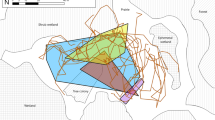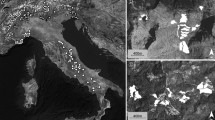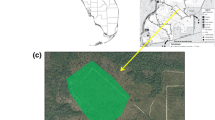Abstract
Poweshiek skipperling (Oarisma poweshiek, Lepidoptera: Hesperiidae) has experienced a range-wide decline resulting in six reported extant sites. Critical knowledge gaps related to Poweshiek skipperling adult behavior, phenology, habitat structure, and potential larval host plants are limiting the ability to manage this federally endangered species. To address these information needs, we conducted extensive surveys in the last remaining stronghold of four extant prairie fens in Michigan. We used point transect surveys to collect data on plant structure, and Poweshiek skipperling behavior and detection. We estimated Poweshiek skipperling abundance and modeled the influence of local vegetation on Poweshiek skipperling presence/absence. We estimated the abundance of adult Poweshiek skipperling in Michigan prairie fens to be 231 (95% CI 160–332), further highlighting the imperiled status of this species. Presence of Poweshiek skipperling along our transects was negatively associated with obstructive vegetation and positively associated with the availability of the nectar source Dasiphora fruticosa. Our observation data indicated females nectared most frequently on D. fruticosa, whereas males nectared most often on Rudbeckia hirta. Across the field season we observed 7 oviposition events on four plant species (Muhlenbergia richardsonis, Muhlenbergia glomerata, Carex sterilis, and D. fruticosa), three of which had no previous documentation as a possible host plant. Results from this study can be used to evaluate management decisions and inform both in situ and ex situ conservation efforts. It is critical to continue monitoring remaining populations, not only to assess conservation efforts, but also to discern the patterns and processes influencing species extinction.







Similar content being viewed by others
References
Albert DA (1995) Regional landscape ecosystems of Michigan, Minnesota, and Wisconsin: a working map and classification. In: Gen. Tech. Rep. NC-178 U.S. Department of Agriculture, Forest Service, North Central Forest Experiment Station, Northern Prairie Wildlife Research Center Online, St. Paul; Jamestown
Bakowski M, Filipiak A, Fric Z (2010) Foraging behaviour and nectar use in adult large copper butterflies, Lycaena dispar (Lepidoptera: Lycaenidae). Entomol Fennica 21:49–57
Baz A (2002) Nectar plant sources for threatened Apollo butterfly (Parnassius apollo L. 1758) in population of central Spain. Biol Conserv 103:277
Belitz MW, Hendrick LK, Monfils MJ, Cuthrell DL, Marshall CJ, Kawahara AY, Cobb NS, Zaspel JM, Horton AM, Huber SL, Warren AD, Forthaus GA, Monfils AK (2018) Aggregated occurrence records of the federally endangered Poweshiek skipperling (Oarisma poweshiek). Biodivers Data J 6:e29081
Boggs CL (1997) Reproductive allocation from reserves and income in butterfly species with differing adult diets. Ecology 78:181–191
Boggs CL, Ross CL (1993) The effect of adult food limitation on life history traits in Speyeria Mormonia (Lepidoptera: Nymphalidae). Ecology 74:433–441
Borkin SS (1995) 1994 Ecological studies of the Poweshiek skipper (Oarisma poweshiek) in Wisconsin. Milwaukee Public Museum, Milwaukee, Wisconsin. http://www.fwspubs.org/doi/suppl/10.3996/052015-JFWM-049/suppl_file/052015-jfwm-049.s1.pdf?code=ufws-site. Accessed 23 May 2018
Brink D (1982) A bonanza-blank pollinator reward schedule in Delphinium nelsonii (Ranunculaceae). Oecologia 52:292–294
Brückmann SV, Krauss J, Steffan-Dewenter I (2010) Butterfly and plant specialists suffer from reduced connectivity in fragmented landscapes. J Appl Ecol 47:799–809
Buckland ST, Anderson DR, Burnham KP, Laake JL, Borchers DL, Thomas L (2001) Introduction to distance sampling: estimating abundance of biological populations. Oxford University Press, Oxford
Burnham KP, Anderson DR (2002) Model selection and multimodel inference: a practical information-theoretic approach, 2nd edn. Springer, New York
Calabrese JM, Fagan WF (2004) Lost in time, lonely, and single: reproductive asynchrony and the Allee effect. Am Nat 164:25–37
Calabrese JM, Ries L, Stephen F, Debinski DM, Auckland JN, Roland J, William F (2008) Reproductive asynchrony in natural butterfly populations and its consequences for female matelessness. J Anim Ecol 77:746–756
Cimprich DA (2009) Effect of count duration on abundance estimates of black-capped Vireos. J Field Ornithol 80:94–100
COSEWIC (2014) Assessment and the status report on the Poweshiek skipperling Oarisma poweshiek in Canada. https://www.registrelep-sararegistry.gc.ca/virtual_sara/files/cosewic/sr_Poweshiek%20Skipperling_2014_e.pdf. Accessed 23 May 2018
Cuthrell DL, Slaughter SL (2012) Special animal abstract for Oarisma poweshiek (Poweshiek skipperling). Michigan natural features inventory, Lansing. https://mnfi.anr.msu.edu/abstracts/zoology/Oarisma_poweshiek.pdf. Accessed 6 Mar 2018
Delphey P, Runquist E, Harris T, Nordmeyer C, Smith T, Traylor-Hozer K, Miller PS (2016) Poweshiek skipperling and Dakota skipper: Ex situ feasibility assessment and planning workshop. IUCN/SSC Conservation Breeding Specialist Group, Apple Valley. https://portals.iucn.org/library/sites/library/files/documents/Rep-2016-004.pdf. Accessed 23 May 2018
Dupont J (2011) Minutes from the Poweshiek skipperling workshop, March 24 and 25, Winnipeg. http://www.fwspubs.org/doi/suppl/10.3996/052015-JFWM-049/suppl_file/052015-jfwm-049.s6.pdf. Accessed 23 May 2018
Ehl S, Hostert K, Korsch J, Gros P, Schmitt T (2018) Sexual dimorphism in the alpine butterflies Boloria pales and Boloria napaea: differences in movement and foraging behavior (Lepidoptera: Nymphalidae). Insect Sci 25:1089–1101
Ehrlich PR, Gilbert LE (1973) Population structure and dynamics of the tropical butterfly Heliconius ethilla. Biotropica 5:69–82
Fourcade Y, Öckinger E (2017) Host plant density and patch isolation drive occupancy and abundance at a butterfly’s northern range margin. Ecol Evol 7:331–345
Hackett RA, Monfils MJ, Monfils AK (2016) Evaluating a sampling protocol for assessing plant diversity in prairie fens. Wetl Ecol Manage 24:609–622
Henry EH, Anderson CT (2016) Abundance estimates to inform butterfly management: double-observer versus distance sampling. J Insect Conserv 20:505–514
Henry EH, Schultz CB (2013) A first step towards successful conservation: understanding local oviposition site selection of an imperiled butterfly, mardon skipper. J Insect Conserv 17:183–194
Henry EH, Haddad NM, Wilson J, Hughes P, Gardner B (2015) Point-count methods to monitor butterfly populations when traditional methods fail: a case study with Miami blue butterfly. J Insect Conserv 19:519–529
Hill C (1992) Temporal changes in abundance of two Lycaenid butterflies (Lycaenidae) in relation to adult food resources. J Lepidopterist’s Soc 46:173–181
Holzman RW (1972) Eastern range extension for Oarisma powesheik Parker (Lepidoptera: Hesperiidae). Great Lakes Entomol 5:111–114
Jervis MA, Boggs CL, Ferns PN (2005) Egg maturation strategy and its associated trade-offs: a synthesis focusing on Lepidoptera. Ecol Entomol 30:359–375
Kost MA, Albert DA, Cohen JG, Slaughter BS, Schillo RK, Weber CR, Chapman KA (2007) Natural communities of Michigan: classification and description. Michigan Natural Features Inventory, Report No. 2007-21, Lansing. https://mnfi.anr.msu.edu/reports/2007-21_Natural_Communites_of_Michigan_Classification_and_Description.pdf. Accessed 6 Mar 2018
Kral KC, Harmon JP, Limb RR, Hovick TJ (2018a) Improving our science: the evolution of butterfly sampling and surveying methods over time. J Insect Conserv 22:1–14
Kral KC, Hovick TJ, Limb RF, Harmon JP (2018b) Multi-scale considerations for grassland butterfly conservation in agroecosystems. Biol Conserv 226:196–204
Landis DA, Fiedler AK, Hamm CA, Cuthrell DL, Schools EH, Pearsall DR, Herbert ME, Doran PJ (2012) Insect conservation in Michigan prairie fen: addressing the challenge of global change. J Insect Conserv 16:131–142
Lee DC, Marsden SJ (2008) Adjusting count period strategies to improve the accuracy of forest bird abundance estimates from point transect distance sampling surveys. Ibis 150:315–325
Marquardt SR, Annis M, Drum RG, Hummel SL, Mosby DE, Smith T (2018) On the cutting edge of research to conserve at-risk species: maximizing impact through partnerships. Integr Comp Biol 58:1–10
Marschalek DA, Deutschmann DH (2008) Hermes copper (Lycaena [Hermelycaena] hermes: Lycaenidae): life history and population estimation of a rare butterfly. J Insect Conserv 12:97–105
McAlpine WS (1972) Observations on life history of Oarisma poweshiek. J Res Lepidoptera 11:83–93
McCabe TL, Post RL (1977) Skippers (Hesperioidea) of North Dakota. North Dakota insects publication no. 11. Department of Entomology and Agricultural Experiment Station, North Dakota State University, Fargo
Michigan Natural Features Inventory (2014) Biotics 5—Michigan’s natural heritage database. Lansing
Murphy D (1988) Are we studying our endangered butterflies to death? J Res Lepid 26:236–239
Nowicki P, Settele J, Henry P, Woyciechowski M (2008) Butterfly monitoring methods: the ideal and the real world. Isreal J Ecol Evol 54:69–88
Peak RG (2011) A field test of the distance sampling method using golden-cheeked Warblers. J Field Ornithol 82:311–319
Pogue CD, Monfils MJ, Cuthrell DL, Heumann BW, Monfils AK (2016) Habitat suitability modeling of the federally endangered Poweshiek skipperling in Michigan. J Fish Wildl Manag 7:359–368
Pointon H (2015) Larval host plant selection and daily behavior of Poweshiek skipperling (Oarisma poweshiek) in Michigan. Undergraduate Thesis, Kalamazoo College
Pollard E, Yates TJ (1993) Monitoring butterflies for ecology and conservation. Chapman and Hall, London
Refsnider JM, Janzen FJ (2010) Putting eggs in one basket: ecological and evolutionary hypotheses for variation in oviposition-site choice. Annu Rev Ecol Evol Syst 41:39–57
Reznicek AA, Voss EG, Walters BS (2011) Michigan Flora online. In: University of Michigan. Web. https://michiganflora.net. Accessed 22 Mar 2019
Rich T, Rabane M, Fasham M, McMeechan F, Dobson D (2005) Ground and shrub vegetation. In: Hill D, Fasham M, Tucker G, Shewry M, Shaw P (eds) Handbook of biodiversity methods—survey, evaluation and monitoring. Cambridge University Press, Cambridge, pp 201–221
Rosengren EC, Andow DA (2016) Spatiotemporal patterns of population decline in Oarisma poweshiek (Hesperiidae) in Michigan and Minnesota between 1990 and 2013. Great Lakes Entomol 49:27–35
Rosenstock SS, Anderson DR, Giesen KM et al (2002) Landbird counting techniques: current practices and an alternative. Auk 119:46–53
Runquist E, Heimpel GE (2017) Potential causes of declines in Minnesota’s prairie butterflies with a focus on insecticidal control of the soybean aphid. Prepared for College of Food, Agricultural and Natural Resource Sciences—University of Minnesota. https://mitppc.dl.umn.edu/sites/g/files/pua746/f/media/mitppc_soybean.final_.pdf Accessed 22 Apr 2018
Rusterholtz H, Erhardt A (2000) Can nectar properties explain sex-specific flower preferences in the Adonis Blue butterfly Lysandra bellargus? Ecol Entomol 25:81–90
Saarinen EV, Reilly PF, Austin JD, Packer L (2016) Conservation genetics of an endangered grassland butterfly (Oarisma poweshiek) reveals historically high gene flow despite recent and rapid range loss. Insect Conserv Divers 9:517–528
Schlicht D, Swengel A, Swengel S (2009) Meta-analysis of survey data to assess trends of prairie butterflies in Minnesota, USA during 1979–2005. J Insect Conserv 13:429–447
Schneider C, Dover J, Fry GLA (2003) Movement of two grassland butterflies in the same habitat network: the role of adult resources and size of the study area. Ecol Entomol 28:219–227
Schultz CB, Crone EE (2015) Using ecological theory to develop recovery criteria for an endangered butterfly. J Appl Ecol 52:1111–1115
Schultz CB, Dlugosch KM (1999) Nectar and hostplant scarcity limit populations of an endangered Oregon butterfly. Oecologia 119:231–238
Schultz CB, Henry E, Carleton A, Hicks T, Thomas R, Potter A, Collins M, Linders M, Fimbel C, Black SH, Anderson H, Diehl G, Hamman S, Gilbert R, Foster J, Hays D, Page N, Heron J, Kroeker N, Webb C, Reader B (2011) Conservation of prairie-oak butterflies in Oregon, Washington, and British Columbia. Northwest Sci 85:361–388
Seixas RR, Santos SE, Okada Y, Freitas AVL (2017) Population biology of the sand forest specialist butterfly Heliconius hermathena. J Lepid Soc 71:133–140
Selby G (2005) Status assessment and conservation guidelines: Poweshiek skipperling (Oarisma poweshiek (Parker) (Lepidoptera: Hesperiidae). Prepared for Twin Cities Field Office, U.S. Fish and Wildlife Service, Bloomington. http://dx.doi.org/10.3996/052015-JFWM-049.S8. Accessed 24 May 2018
Semmler SJ (2010) The nectar sources and flower preferences of the Poweshiek Skipperling (Oarisma poweshiek) in Manitoba. Honours Thesis, University of Winnipeg. http://ion.uwinnipeg.ca/~moodie/Theses/Semmler2010.pdf. Accessed 27 Apr 2018
Severns PM, Warren AD (2008) Selectively eliminating and conserving exotic plants to save an endangered butterfly from local extinction. Anim Conserv 11:476–483
Severns PM, Boldt L, Villegas S (2006) Conserving a wetland butterfly: quantifying early lifestage survival through seasonal flooding, adult nectar, and habitat preference. J Insect Conserv 10:361–370
Simons TR, Alldredge MW, Pollock KH et al (2007) Experimental analysis of the auditory detection process on avian point counts. Auk 124:986–999
Singer MC, Wedlake P (1981) Capture does affect probability of recapture in a butterfly species. Ecol Entomol 6:215–216
Spieles JB, Comer PJ, Albert DA, Kost MA (1999) Natural community abstract for prairie fen. Michigan Natural Features Inventory, Lansing
Swengel AB (1996) Effects of fire and hay management on abundance of prairie butterflies. Biol Conserv 76:73–85
Swengel AB, Swengel SR (1999) Observations of prairie skippers (Oarisma poweshiek, Hesperia dacotae, H. ottoe, H. leonardus pawnee, and Antrytone arogos iowa) [Lepidoptera: Hesperiidae] in Iowa, Minnesota, and North Dakota during 1988-1997. Great Lakes Entomol 32:267–292
Swengel AB, Swengel SR (2014) Paradoxes of Poweshiek skipperling (Oarisma poweshiek) (Lepidoptera: Hesperiidae): abundance patterns and management of a highly imperiled prairie species. ISRN Entomology. https://doi.org/10.1155/2014/216427
Swengel SR, Schlicht D, Olsen F, Swengel AB (2011) Declines of prairie butterflies in the midwestern USA. J Insect Conserv 15:327–339
Sykes JM, Horrill AD, Mountford MD (1983) Use of visual cover assessments as quantitative estimators of some British woodland taxa. Ecology 71:437–450
Szcodronski KE, Debinski DM, Klaver RW (2018) Occupancy modeling of Parnassius clodius butterfly populations in Grand Teton National Park, Wyoming. J Insect Conserv 22:267–276
Thomas RC, Schultz CB (2016) Resource selection in an endangered butterfly: females select native nectar species. J Wildl Manag 80:171–180
Thomas JA, Simcox DJ, Clarke RT (2009) Successful conservation of a threatened Maculinea butterfly. Science 325:80–84
Thomas L, Buckland ST, Rexstad EA et al (2010) Distance software: design and analysis of distance sampling surveys for estimating population size. J Appl Ecol 47:5–14
Thomas JA, Simcox DJ, Hovestadt T (2011) Evidence based conservation of butterflies. J Insect Conserv 15:241–258
U.S. Fish and Wildlife Service (USFWS) (2014) Endangered and threatened wildlife and plants; threatened species status for dakota skipper and endangered Species status for poweshiek skipperling. Federal Register 79 FR 63671
Vlasanek P, Hauck D, Konvicka M (2009) Adult sex ratio in the Parnassius mnemosyne butterfly: effects of survival, migration, and weather. Israel J Ecol Evol 55:233–252
WallisDeVries MF, Poschlod P, Willems JH (2002) Challenges for the conservation of calcareous grasslands in northwestern Europe: integrating the requirements of flora and fauna. Biol Conserv 104:265–273
Weking S, Hermann G, Fartmann T (2013) Effects of mire type, land use and climate on a strongly declining wetland butterfly. J Insect Conserv 17:1081–1091
Wiklund C (1984) Egg-laying patterns in butterflies in relation to their phenology and the visual apparency and abundance of their host plants. Oecologia 63:23–29
Yates F (1934) Contingency tables involving small numbers and the χ2 test. J R Stat Soc 1:217–235
Acknowledgements
T Gehring provided valuable editorial suggestions and G Forthaus assisted with data curation. We thank our reviewers for comments that improved the manuscript. We thank B Cahill, R Hackett, C Pogue, L Hendrick, K Finch, M Schott, and M Parr for conducting field surveys. Additionally, we thank the landowners, including the Michigan Nature Association, Oakland County, Springfield Township, Michigan Department of Natural Resources, and private landowners, for allowing us access to their properties for survey activities. Finally, we are grateful to the members of the Partnership for Poweshiek skipperling Conservation for their continued long-term dedication to this species. Research funding was provided by the Great Lakes Restoration Initiative through the U.S. Fish and Wildlife Service’s Endangered Species Program, Central Michigan University—College of Science and Engineering’s Dean’s Research Assistantship, and Central Michigan University Biology Department—Marion Whitney Summer Graduate Scholarship. The findings and conclusions in this project are those of the authors and do not necessarily represent the views of the U.S. Fish and Wildlife Service or the U.S. Environmental Protection Agency. Funding also came from the National Science Foundation award DBI-1730526 to develop educational materials for biodiversity data literacy (https://www.biodiversityliteracy.com/poweshiek-skipperling). This paper is contribution number 125 of the Central Michigan University Institute for Great Lakes Research.
Author information
Authors and Affiliations
Corresponding author
Ethics declarations
Conflict of interest
The authors declare that they have no conflict of interest.
Informed consent
This article does not contain any studies with human participants.
Research involving human participants and/or animals
This article does not contain any studies where animals were manipulated. All data were collected by observations and researchers did not handle animals. We had an incidental take permit through the U.S. Fish and Wildlife service, which outlined how we would minimize and mitigate authorized incidental take of Oarisma poweshiek.
Additional information
Publisher's Note
Springer Nature remains neutral with regard to jurisdictional claims in published maps and institutional affiliations.
Rights and permissions
About this article
Cite this article
Belitz, M.W., Monfils, M.J., Cuthrell, D.L. et al. Life history and ecology of the endangered Poweshiek skipperling Oarisma poweshiek in Michigan prairie fens. J Insect Conserv 23, 635–649 (2019). https://doi.org/10.1007/s10841-019-00158-6
Received:
Accepted:
Published:
Issue Date:
DOI: https://doi.org/10.1007/s10841-019-00158-6




